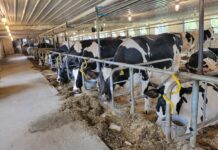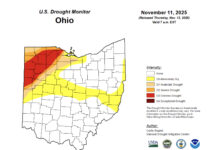Crop profitability prospects for 2013 are positive for the three major row crops in Ohio. Input costs have increased from last year, but high crop futures prices for 2013 crops will allow producers to plan for positive margins next year.
OSU Extension enterprise budget projections show positive returns for corn, soybeans and wheat in 2013. These budgets are available online at: http://aede.osu.edu/programs/farmmanagement.
OSU Extension budgets show projected variable (cash) costs for corn, soybean, and wheat production to be 4 percent, 6 percent and 2.5 percent higher, respectively in 2013 versus 2012.
Risky year?
Higher commodity prices and higher costs point to another risky production year, as the cash investment in an acre of corn will top $400 (excluding land, machinery and labor costs) and in some production scenarios be closer to $450 per acre.
The cash investment in an acre of soybeans or wheat will be in the $200-$260 range.
Fuel
The Energy Information Administration estimates the average price for Brent crude oil at $103.75 per barrel for 2013 which is a 7.3 percent decrease from 2012. This is due to slightly lower oil consumption growth projections for 2013.
The EIA projects natural gas prices to increase 3 percent in 2013. Expected tightness in the market is the reasoning, but this projection is harder to reconcile with the increased production capabilities in the U.S.
Fertilizer
Fertilizer continues to be the most volatile of the crop input costs and cost management of this important input may be the difference in being a low cost or high cost producer in 2013.
Fertilizer products have seen prices slightly higher to slightly lower compared to last year. Increases over last year likely will continue to increase due to higher crop commodity prices and positive profitability prospects for 2012.
Healthier farmer balance sheets and continued positive crop profit prospects have signaled the global marketplace to increase acreage (if possible) and maintain or increase fertilizer rates and led to strong global demand driven markets.
On the flipside, the E.U. and U.S. sovereign debt issues and potential economic slowdowns are factors, if unresolved, may lead to a slowdown in fertilizer demand and flat to lower prices.
Nitrogen
The retail price in November/December in Ohio was $845-925/ton for anhydrous ammonia (5 percent increase over year ago) and $388-460/ton for UAN (28 percent) (7 percent increase over year ago).
Factors that may lead to N price increases include:
♦ High crop prices and crop profitability.
♦ Large corn acreage prospects for the U.S. again.
♦ Strong farm balance sheet.
♦ Mississippi barge traffic may be delayed due to low water levels.
♦ Factors that may lead to N price decreases include:
♦ Slow world economy.
♦ Low domestic natural gas price.
♦ More domestic N production coming online Giesmer, La; Donaldsville, La; Augusta, Ga; etc.
♦ More domestic N production to be built — approximately 9.3m tons (present capacity 13m t).
Nitrogen fertilizer manufacturers are presently operating at profitable levels due to higher N prices and relatively low natural gas prices, but this fact hasn’t led to supply outstripping demand as the entire supply chain has been more cautious in getting caught in a repeat of the 2008 upside-down fertilizer market.
With the high correlation of nitrogen price to corn price, future movements in nitrogen prices will more than likely take their cues from movements in price of corn.
There may continue to be a disconnect between foreign/domestic port prices and Midwest prices as the low Mississippi river levels continue to restrict fright up and down the river.
Phosphorous. Di-ammonium Phosphate in November/December in Ohio was $634-690/ton (9 percent decrease over year ago) while mono-ammonium phosphate (MAP) was $644-700/ton (9 percent decrease over year ago).
Factors that may lead to P price increases include:
♦ High crop prices and crop profitability
♦ Strong farm balance sheet
♦ Mississippi barge traffic may be delayed due to low water levels
♦ Factors that may lead to P price decreases include:
♦ Slow world economy
♦ Residual soil P (due to drought) may dampen demand
Potassium
The retail price of potash in December in Ohio was $555-640/ton (7 percent decrease from year ago).
The potash industry essentially operates as a duopoly (two firms, in this case, two consortiums, with dominant control of the market) with Canpotex (Canadian Potash Exporters) and Bellarussian Potash Co. controlling much of the global potash supply.
Factors that may lead to K price increases include:
♦ High crop prices and crop profitability.
♦ Strong farm balance sheet.
♦ Potash Producers have begun to curtail production.
♦ Factors that may lead to K price decreases include:
♦ Slow world economy.
♦ Residual soil K (due to drought) may dampen demand.
Seed and crop protection chemicals
Company price data and industry sources indicate seed prices for 2013 to be 5 percent to10 percent higher.
Crop protection chemical prices will see similar increases except glyphoste, which has seen a 50 percent increase in price for many of the different glyphosate products.
For more information on AEDE/OSU Extension Policy and Outlook offerings: http://aede.osu.edu/programs-and-research/agricultural-policy-and-outlook-conferences.
(Barry Ward is the leader of production business management in the Ohio State University Extension’s department of agricultural, environmental and development economics.)












